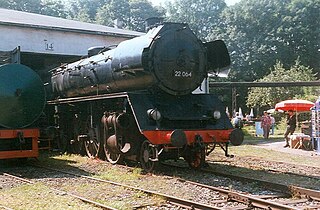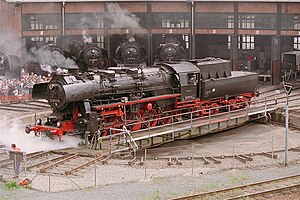
The Deutsche Reichsbahn's Class 52 is a German steam locomotive built in large numbers during the Second World War. It was the most produced type of the so-called Kriegslokomotiven or Kriegsloks. The Class 52 was a wartime development of the pre-war DRG Class 50, using fewer parts and less expensive materials to speed production. They were designed by Richard Wagner who was Chief Engineer of the Central Design Office at the Locomotive Standards Bureau of the DRG. About a dozen classes of locomotive were referred to as Kriegslokomotiven; however, the three main classes were the Class 52, 50 and 42. They were numbered 52 1-52 7794. A total of 20 are preserved in Germany.

The DRB Class 50 is a German class of 2-10-0 locomotive, built from 1939 as a standard locomotive (Einheitsdampflokomotive) for hauling goods trains. It had one leading axle and five coupled axles and was one of the most successful designs produced for the Deutsche Reichsbahn.

The Bavarian Class D XII steam locomotives were manufactured by the firm of Krauss from 1897 for the Royal Bavarian State Railways. Ninety six of them were procured for service on the stub lines running from Munich into the mountains, but in reality they were stationed in many large Bavarian locomotive depots. Two engines were transferred to the Palatinate Railway (Pfalzbahn) in 1916, the remaining 94 later joined the Deutsche Reichsbahn fleet and were incorporated as DRG Class 73.0-1 with operating numbers 73 031–124.

The DRB Class 42 was a type of steam locomotive produced for the Deutsche Reichsbahn. It is one of the three main classes of the so-called war locomotives (Kriegslokomotiven), the other two being class 50 and 52.

The Class 80 tank engines were German standard locomotives (Einheitsloks) with the Deutsche Reichsbahn. They were intended to replace the aging, rickety state railway line engines performing shunting duties in their dotage at large stations.

The German Class 41 steam locomotives were standard goods train engines (Einheitslokomotiven) operated by the Deutsche Reichsbahn (DRB) and built from 1937 to 1941.

The German term Rekonstruktionslokomotive meant 'reconstruction locomotive' and was introduced in 1957 by the Deutsche Reichsbahn in the GDR.

The Class 62 engines were standard passenger train tank locomotives of Germany's Deutsche Reichsbahn-Gesellschaft (DRG).

The DRG Class 89.0 was a goods train tank engine of standard design built for the Deutsche Reichsbahn (DRG).

The two German DRG Class 61 steam engines were express train locomotives specifically built by Henschel for the Henschel-Wegmann train in service with the Deutsche Reichsbahn. The Henschel-Wegmann train was an initiative of the German locomotive construction industry, intended to be able to demonstrate a powerful steam locomotive-hauled train alongside the emerging express diesel multiple units, such as the Hamburg Flyer.

The German Class 03.10 engines were standard steam locomotives (Einheitsdampflokomotiven) belonging to the Deutsche Reichsbahn and designed for hauling express trains.

The Prussian T 18 was the last class of tank locomotives developed for the Prussian state railways. They were originally intended for services on the island of Rügen as replacements for Class T 12 and T 10 engines. They emerged when a class of locomotive was conceived in 1912 that was to handle express and passenger trains in border areas or in shuttle services on short routes. A tank engine design with symmetrical running gear was envisaged because, unlike a tender locomotive, it could run equally fast forwards and backwards and could be operated on return journeys without having to be turned on a turntable. Its power and top speed were to be the same as those of the P 8. Robert Garbe designed this 4-6-4 (2′C2′) tank locomotive for 100 km/h with a 17-ton axle load and contracted the Vulkan Werke in Stettin to build it. It was given the designation T 18.
The Mecklenburg T 3 was a German, goods train, tank locomotive built for the Grand Duchy of Mecklenburg Friedrich-Franz Railway from 1884. Originally designated as the Class XVII it had an 0-6-0T wheel arrangement and was based on the Prussian T 3.

The DR Class 65.10 was a four-coupled passenger train tank engine operated by the East German Deutsche Reichsbahn (DR) for heavy suburban and commuter services.

The steam locomotives of DR Class 22 were reconstructed passenger train locomotives in service with the Deutsche Reichsbahn in East Germany after the Second World War.

After the Second World War, the Deutsche Reichsbahn in East Germany had a requirement for powerful goods train locomotives with a 15-18 tonne axle load for routes in the Mittelgebirge, the mountainous areas in the south of the country. As a result, the DR Class 58.30 emerged, as part of the so-called 'reconstruction programme', based on rebuilds of the former Prussian G 12 locomotives. Between 1958 and 1962, 56 locomotives, originally from various state railways were converted at the former repair shop, RAW Zwickau.

The DR Class 01.5 was the designation given by the Deutsche Reichsbahn in East Germany to express train locomotives that were 'reconstructed' from those of the pre-war DRG Class 01.

In 1905 the Prussian state railways grouped six-coupled, medium-powered, goods train, tank locomotives into its Class G 3. In addition to standard locomotives, there were also 285 G 3s that were not built to German state railway norms, because they had been built, in most cases, before the foundation of the Prussian state railways.

The Saxon Class VII T were twin-coupled tank engines of the Royal Saxon State Railways designed for branch line (Sekundärbahn) operations. In 1925, the Deutsche Reichsbahn grouped these locomotives 1925 into their Class 98.70.

The class IV h (four-h) locomotives of the Grand Duchy of Baden State Railway (German: Großherzoglich Badische Staatseisenbahnen, G.Bad.St.E.) were express locomotives with a 4-6-2 (Pacific) wheel arrangement. They later passed to the Deutsche Reichsbahn, who classified them as class 183.


























